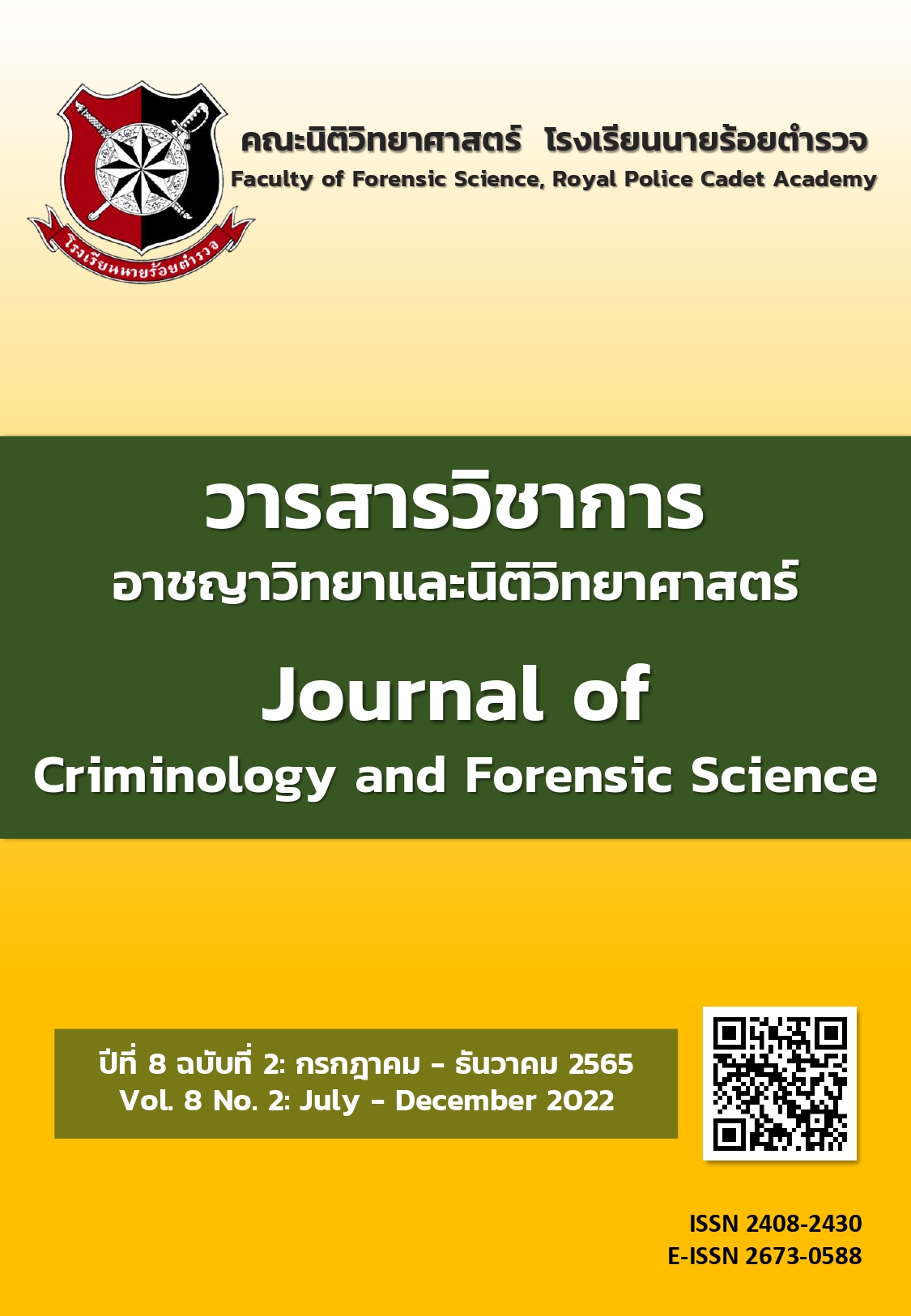กลยุทธ์ในการจัดการพยานหลักฐานที่เกี่ยวข้องกับการรักษาความปลอดภัย ของการไฟฟ้าฝ่ายผลิตแห่งประเทศไทย
Main Article Content
บทคัดย่อ
นิติวิทยาศาสตร์เป็นการนำวิทยาศาสตร์มาใช้ในการพิสูจน์พยานหลักฐาน นอกจากนั้นยังต้องนำความก้าวหน้าทางเทคโนโลยีมาเชื่อมโยงกับองค์ความรู้ทางนิติวิทยาศาสตร์เพื่อนำไปสู่การนำพยานหลักฐานต่าง ๆ มาใช้ในการบริหารจัดการกลยุทธ์งานด้านการรักษาความปลอดภัยของการไฟฟ้าฝ่ายผลิตแห่งประเทศไทย (กฟผ.) โดยการวิจัยมีวัตถุประสงค์เพื่อศึกษาระดับความสัมพันธ์ของพยานหลักฐาน นวัตกรรม เทคโนโลยีสารสนเทศและการสื่อสาร และระบบการตรวจสอบความปลอดภัยที่ส่งผลต่อกลยุทธ์ในการจัดการพยานหลักฐานที่เกี่ยวข้องกับการรักษาความปลอดภัย และอิทธิพลของความสัมพันธ์เพื่อการพัฒนารูปแบบกลยุทธ์ที่เกี่ยวข้องกับการรักษาความปลอดภัยของการไฟฟ้าฝ่ายผลิตแห่งประเทศไทย งานวิจัยนี้ใช้วิธีการผสมผสานระหว่างการวิจัยเชิงปริมาณและการวิจัยเชิงคุณภาพ กลุ่มตัวอย่างของ
การวิจัยเชิงปริมาณ คือ เจ้าหน้าที่ของการไฟฟ้าฝ่ายผลิตแห่งประเทศไทย จำนวน 340 คน โดยใช้แบบสอบถาม และผู้ให้ข้อมูลหลักของการวิจัยเชิงคุณภาพ คือ ผู้ที่มีความรู้ความเชี่ยวชาญที่มีประสบการณ์และปฏิบัติงานที่เกี่ยวข้องกับงานรักษาความปลอดภัย จำนวน 15 คน โดยวิธีการสัมภาษณ์เจาะลึก
และนำมาวิเคราะห์โดยการใช้สถิติเชิงพรรณนาและแบบจำลองสมการเชิงโครงสร้าง ผลการวิจัย พบว่า
1) ระดับความสัมพันธ์ของพยานหลักฐาน นวัตกรรม เทคโนโลยีสารสนเทศและการสื่อสารและระบบ
การตรวจสอบความปลอดภัยส่งผลต่อกลยุทธ์ในการจัดการพยานหลักฐานเห็นด้วยในระดับมาก
และ 2) ตัวแปรที่มีอิทธิพลต่อกลยุทธ์ในการจัดการพยานหลักฐานที่เกี่ยวข้อง ได้แก่ ระบบตรวจสอบ
ความปลอดภัย โดยการเข้าออกพื้นที่ต้องมีการกำหนดกลยุทธ์รูปแบบที่มีเทคโนโลยีและนวัตกรรมใหม่
โดยการนำไบโอเมทริกซ์หรือข้อมูลอัตลักษณ์บุคคลสำหรับพิสูจน์ยืนยันตัวบุคคลที่ผสมผสานด้านชีวภาพและด้านการแพทย์กับเทคโนโลยีทางคอมพิวเตอร์เข้าด้วยกัน โดยผลการวิจัยนี้พยานหลักฐานทาง
นิติวิทยาศาสตร์สามารถนำมาใช้ในเชิงองค์ความรู้ใหม่โดยใช้เทคโนโลยีและนวัตกรรมใหม่ที่เป็นประโยชน์ต่อกลยุทธ์ในการจัดการพยานหลักฐานที่เกี่ยวข้องกับการรักษาความปลอดภัยของการไฟฟ้าฝ่ายผลิตแห่งประเทศไทยได้
Article Details

อนุญาตภายใต้เงื่อนไข Creative Commons Attribution-NonCommercial-NoDerivatives 4.0 International License.
เนื้อหาและข้อมูลในบทความที่ลงตีพิมพ์ใน วารสารวิชาการอาชญาวิทยาและนิติวิทยาศาสตร์ โรงเรียนนายร้อยตำรวจ ถิอว่าเป็นข้อคิดเห็นและความรั้บผิดชอบของผู้เขียนบทความโดยตรงซึ่งกองบรรณาธิการวารสาร ไม่จำเป็นต้องเห็นด้วยหรือรับผิดชอบใดๆ
บทความ ข้อมูล เนื้อหา รูปภาพ ฯลฯ ที่ได้รับการตีพิมพ์ใน วารสารวิชาการอาชญาวิทยาและนิติวิทยาศาสตร์ ถือว่าเป็นลิขสิทธิ์ของวารสาร วารสารวิชาการอาชญาวิทยาและนิติวิทยาศาสตร์ หากบุคคลหรือหน่วยงานใดต้องการนำทั้งหมดหรือส่วนหนึ่งส่วนใดไปเผยแพร่ต่อหรือเพื่อกระทำการใดๆ จะต้องได้รับอนุญาตเป็นลายลักษณ์อักษรจาก วารสารวิชาการอาชญาวิทยาและนิติวิทยาศาสตร์ ก่อนเท่านั้น
เอกสารอ้างอิง
Barrett, D. (2013). One surveillance camera for every 11 people in Britain, says CCTV survey. Retrieved December 30, 2021. From https://www.telegraph.co.uk/technology/10172298/One-surveillance-camera-for-every-11-people-in-Britain-says-CCTV-survey.html.
Best-Rowden, L., Han, H., Otto, C., Klare, B. & Jain, A. K. (2014). Unconstrained face recognition: identifying a person of interest from a media collection. IEEE Transactions on Information Forensics and Security. 9(12), 2144–2157. http://doi.org/10.1109/tifs.2014.2359577
Choeiprathap, S. (1993). Mass media and national development. Bangkok: Chulalongkorn University. (In Thai).
Christensen, C. M. & Raynor, M. (2003). The innovator's solution: creating and sustaining successful growth. Boston, Mass.: Harvard Business School Press.
Dror, I. E., Wertheim, K., Fraser-Mackenzie, P. & Walajtys, J. (2012). The impact of human–technology cooperation and distributed cognition in forensic science: biasing effects of AFIS contextual information on human experts. Journal of Forensic Sciences. 57(2), 343–352. http://doi.org/10.1111/j.1556-4029.2011.02013.x
Electricity Generating Authority of Thailand (2019). Digitalization Roadmap. Retrieved December 20, 2020. From https://www.egat.co.th/egattoday/images/pr-egat/egatnews/EGATNEWS-62-03.pdf. (In Thai).
Engsomboon, S. (2008). Introduction of Crime Scene Investigation. Nakhon Pathom:
Royal Police Cadet Academy. (In Thai).
Fuller, J., (2015). Locard's Exchange Principle – How stuff works. Retrieved January 15, 2021. From http://science.howstuffworks.com/locards-exchange-principle2.html.
Gelb, A. & Clark, J. (2013). Identification for development: the biometrics revolution. Technical report. Washington, DC: Center for Global Development.
Inman, K. & Rudine, N. (2002). The Origin of evidence. Forensic Science International
(1). 11-16. https://doi.org/10.1016/S0379-0738(02)00031-2.
Jasmine Telecom Systems PCL. (2020). Security System. Retrieved January 15, 2021. From
http://www.jts.co.th/th/component/content/56.html.
Kechonnan, N. (2002). Human Resource Management. Bangkok: SE-Eduaction. (In Thai).
Manocharoen, K. & Jarintho, K. (2012). Strategic management of EGAT: a case study of bangpakong power plant. RMUTT Global Business and Economics Review. 7(2). 97-108. (In Thai).
Meuwly, D. & Veldhuis, R. (2012). Forensic biometrics: from two communities to one discipline. Proceedings of the International Conference of Biometrics Special Interest Group (BIOSIG), Vol 2. September 6–7, 2012. Germany. (In Thai).
Mnookin, J. L., et.al. (2011). The need for a research culture in the forensic sciences. SSRN Electronic Journal. 58(3), 725–779. http://doi.org/10.2139/ssrn.1755722.
Neumann, C., Evett, I. W. & Skerrett, J. (2012). Quantifying the weight of evidence from a forensic fingerprint comparison: a new paradigm. Journal of the Royal Statistical Society, 175(2), 371–415. https://doi.org/10.1111/j.1467-985X.2011.01027.
Pakdeethanakul, C. (2016). Explanation of law of Evidence. Bangkok: Institute of Legal Education Thai Bar Association. (In Thai).
Phromsri, C., Chaikusin, S. & Kaeochueaknang, W. (2017). Development of Security Measures Assessment for Private Organization. Bangkok: Rajamangala University of Technology Phra Nakhon. (In Thai).
Rabieboat, K. (2015). Strategic Management of Security Businesses Conforming to the Security Business Act. Master of Business Administration. Rajamangala University of Technology Thanyaburi, Pathumthani. (In Thai).
Saengkaeo, P. (2013). Developing a Competency-Based Performance Assessment Model for Employee Development in Security Business. Philosophy of Business Administration. King Mongkut's University of Technology North Bangkok, Bangkok. (In Thai).
Venkatesh, V., Morris, M. G., Davis, F. D., & Davis, G. B. (2003). User Acceptance of Information Technology : Toward a Unified View. Management Information Systems Quarterly. 27(3), 425-478. https://doi.org/10.2307/30036540.
White, J. H. et al., (2011). The utilization of forensic science and criminal profiling for
capturing serial killers. Forensic Science International. 209(1-3), 160-165.


